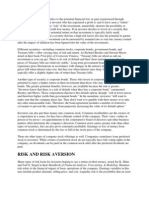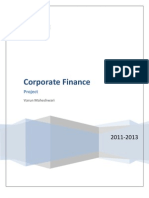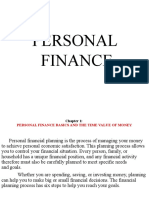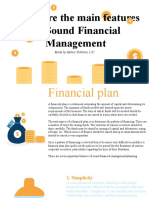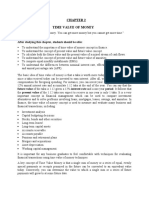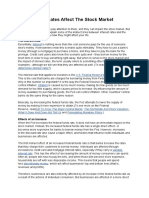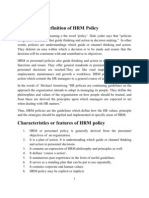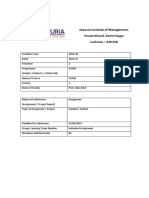Risk and Return Trade Off
Risk and Return Trade Off
Uploaded by
Debabrata SutarCopyright:
Available Formats
Risk and Return Trade Off
Risk and Return Trade Off
Uploaded by
Debabrata SutarCopyright
Available Formats
Share this document
Did you find this document useful?
Is this content inappropriate?
Copyright:
Available Formats
Risk and Return Trade Off
Risk and Return Trade Off
Uploaded by
Debabrata SutarCopyright:
Available Formats
Seminar report on
Risk-return tradeoff
Submitted by
Pradip Routh Reg. no - 0906247013
Introduction :People have many motives for investing. For most investors, however, their interest in investment is largely pecuniary- to earn a return on their money. However, selecting stocks exclusively on the basis of maximization of return is not enough. To sat that investors like return and dislike risks is, however, simplistic. To facilitate our job for analyzing securities and portfolio within a return-risk context are, we must begin with a clear understanding of what risk and return are, what creates them, and how they should be measured. The ultimate decisions to be made in investment are (1) what securities should be held and (2) how much money should be allocated to each. These decisions are normally made in two steps. First estimates are prepared of the return and risk associated with available securities over a forward holding period. This step is known as security analysis. Second risk-return estimates must be compared in order to decide how to allocate available funds among these securities on a continuing basis. Security analysis is built around the idea that investors are concerned with two principle properties inherent in securities; the return that can be expected from holding a security, and the risk that the return that is achieved will be less than the return that was expected. The primary purpose herein is to focus upon return and risk and how they are measured.
Importance :The relationship between risk and return is a fundamental financial relationship that affects expected rates of return on every existing asset investment. The Risk-Return relationship is characterized as being a "positive" or "direct" relationship meaning that if there are expectations of higher levels of risk associated with a particular investment then greater returns are required as compensation for that higher expected risk. Alternatively, if an investment has relatively lower levels of expected risk then investors are satisfied with relatively lower returns. This risk-return relationship holds for individual investors and business managers. Greater degrees of risk must be compensated for with greater returns on investment. Since investment returns reflects the degree of risk involved with the investment, investors need to be able to determine how much of a return is appropriate for a given level of risk. This process is referred to as "pricing the risk". In order to price the risk, we must first be able to measure the risk (or quantify the risk) and then we must be able to decide an appropriate price for the risk we are being asked to bear. This module provides the student with an understanding of various forms of risk that allow the incorporation of risk adjustments into financial management decision making
and the asset pricing processes. In the introductory discussions, different types of risk are defined and explored. At more advanced levels, various definitions of risk are quantified and with the help of financial theory, appropriate risk adjusted returns are identified
Context :Return:The returns on the investment can be broken in to two parts. 1. Dividend/income yield-The reward investor gets by owing this asset over the holding period 2. Capital gain-The gain investor makes upon selling the asset after the holding period. The income from an investment consists of one or more cash payments paid at specified intervals of time. Interest payment on most bonds are paid semi-annually whereas dividends on common stocks are usually paid quarterly. The distinguishing feature of these payments is that they are paid in cash by the issuer to the holder of the asset. Return measurement: Total return=Dividend yield+Capital gain Total % return =(Dividend+capital gain)/Initial investment ={D1+(p1-p0)}/p0 =(D1/p0)+{(p1-p0)/p0} Where D1-Dividend p0-Initial investment P1-Selling price
Example: The current market price of a share is Rs 300.An investor buys 100 shares. After one year he sells these shares at a price of Rs 360 and also receives the dividend of Rs 15 per share. Find out his total return ,% return, dividend yield and capital gains. Solution: Initial investment=300x100=30000
Dividend earned=15x100=1500 Capital gain =(360-300)x100=6000 Total return =1500+6000=7500 Total %return=(7500/30000)x100=25% Dividend yield=(15/300)x100=5% Capital gain =(60/300)=20% Risk: The chance that an investment's actual return will be different than expected. Risk includes the possibility of losing some or all of the original investment. Different versions of risk are usually measured by calculating the standard deviation of the historical returns or average returns of a specific investment. A high standard deviations indicates a high degree of risk. A fundamental idea in finance is the relationship between risk and return. The greater the amount of risk that an investor is willing to take on, the greater the potential return. The reason for this is that investors need to be compensated for taking on additional risk. For example, a Treasury bond is considered to be one of the safest (risk-free) investments and, when compared to a corporate bond, provides a lower rate of return. The reason for this is that a corporation is much more likely to go bankrupt than the U.S. government. Because the risk of investing in a corporate bond is higher, investors are offered a higher rate of return. Risk = Systematic risk + Unsystematic risk Systematic Risk : The risk inherent to the entire market or entire market segment. Also known as un-diversifiable risk or market risk. Interest rates, recession and wars all represent sources of systematic risk because they affect the entire market and cannot be avoided through diversification. Whereas this type of risk affects a broad range of securities, unsystematic risk affects a very specific group of securities or an individual security. Systematic risk can be mitigated only by being hedged. Even a portfolio of well-diversified assets cannot escape all risk.
Systematic Risk is also known as undiversified or uncontrollable risk. It refers to that portion of total variability in return caused by factors affecting the prices of all securities. Economic, political and sociological changes are sources of systematic risk. (1) Market Risk: The day-to-day potential for an investor to experience losses from fluctuations in securities prices. This risk cannot be diversified away. Also referred to as "systematic risk". The beta of a stock is a measure of how much market risk a stock faces. Market risk refers to the variability of returns due to fluctuation in the securities market. Market risk is caused by investor reaction to tangible as well as intangible events. Expectation of lower corporate profit in general may cause the larger body of common stocks to fall in price. The basis for the reaction is a set of real, tangible events like depression, war,politics.Intangible events are related to market psychology The initial decline in the market can cause the fear and all investors make for the exit.
(2) Interest Rate Risk :The risk that an investment's value will change due to a change in the absolute level of interest rates, in the spread between two rates, in the shape of the yield curve or in any other interest rate relationship. Such changes usually affect securities inversely and can be reduced by diversifying (investing in fixed-income securities with different durations) or hedging (e.g. through an interest rate swap). Interest rate risk affects the value of bonds more directly than stocks, and it is a major risk to all bondholders. As interest rates rise, bond prices fall and vice versa. The rationale is that as interest rates increase, the opportunity cost of holding a bond decreases since investors are able to realize greater yields by switching to other investments that reflect the higher interest rate. For example, a 5% bond is worth more if interest rates decrease since the bondholder receives a fixed rate of return relative to the market, which is offering a lower rate of return as a result of the decrease in rates. Interest Rate Risk refers to the uncertainty of future market values and of the size of future income, caused by fluctuations in the general level of interest rates. The root cause of interest rate risk lies in the fact that, as the rate of interest paid on government securities rises or falls .The rate of returns demanded on alternative investment, such as stocks and bonds issued in the private sector, rise or fall. (3) Purchasing Power : The value of a currency expressed in terms of the amount of goods or services that one unit of money can buy. Purchasing power is important because, all else being
equal, inflation decreases the amount of goods or services you'd be able to purchase. In investment terms, the dollar amount of credit available to a customer to buy additional securities against the existing marginable securities in the brokerage account. To measure purchasing power, you'd compare against price index such as CPI. A simple way to think about purchasing power is to imagine if you made the same salary as your grandfather. Clearly you could survive on much less a few generations ago, however, because of inflation, you'd need a greater salary just to maintain the same quality of living. Purchasing power risk refers to the impact of inflation or deflation on an investment .Rising prices on goods and services are normally associated with what is referred to as inflation ,and falling prices on goods and services are termed deflation. Rational investors should include in their estimate of expected return an allowance for purchasing power risk Unsystematic Risk: Company or industry specific risk that is inherent in each investment. The amount of unsystematic risk can be reduced through appropriate diversification. Also known as "specific risk", "diversifiable risk" or "residual risk". For example, news that is specific to a small number of stocks, such as a sudden strike by the employees of a company you have shares in, is considered to be unsystematic risk. Unsystematic Risk is also known as diversified or controllable risk. It is the portion of total risk that is unique to a firm or industry .Factors such as management capability, Consumer preferences, labour strikes cause variability of returns in a firm .Unsystematic factors are largely independent of factors affecting securities markets in general. Because these factors affect one firm, they must be examined for each firm.
(1)Business Risk: The risk that a company will not have adequate cash flow to meet its operating expenses. A company's risk is composed of financial risk, which is linked to debt, and risk, which is often linked to economic climate. If a company is entirely financed by equity, it would pose almost no financial risk, but, it would be susceptible to business risk or changes in the overall economic climate. Business risk can be classified into two ways:
Internal Business Risk External Business Risk. Internal Business Risk is largely associated with the efficiency with which a firm conducts its operations within the broader operating environment imposed upon it. External Business Risk is the result of operating conditions imposes upon the firm by circumstances beyond its control.
(2)Financial Risk : The risk that a company will not have adequate cash flow to meet financial obligations. Financial risk is the additional risk a shareholder bears when a company uses debt in addition to equity financing. Companies that issue more debt instruments would have higher financial risk than companies financed mostly or entirely by equity. Financial risk is associated with the way in which a company finances its activities .We usually take financial risk by looking at the capital structure of a firm .The presence of borrowed money of debt in the capital structure creates fixed payment in the form of interest that must be sustained by the firm. Financial risk is avoidable risk to the extent that management has the freedom to decide to borrow or not to borrow funds. A firm with no debt financing has no financial risk. Beta :Beta is a statistical measure of risk .and capital asset pricing model (capm) links risk (beta) to the level of required return. Total risk=diversifiable risk + non diversifiable risk Studies have shown that by carefully selecting as few as 15 securities for a portfolio diversifiable risk can be almost entirely eliminated. Non diversifiable risk is unavoidable and each security possesses its own level of non diversifiable risk, measured using the beta coefficient. Beta measures non diversifiable risk. Beta shows how a price of a security responds to market forces. The more responds to the price of a security is to changes in the market, the higher will be its beta. Beta is calculated by relating the returns on a security with the returns of the market Market return is measured by the average return of a large sample of stocks such as BSE or NSE index. The beta for overall market is equal to 1.00. Beta can be positive or negative. However all betas are positive and most betas lie somewhere between 0.4 and 1.9. Stocks having betas of less than 1 will of course be less responsive to changing returns in the market and therefore are considered less risky.
Beta is the ratio of covariance between market return and the securitys return to the market return variance. =Cov(j,m)/m2 j- securitys return m- market return
Year 1 2 3 4 5
Market return 18.6 -16.5 63.83 -20.65 -17.87
Jaya InfoTech return 23.46 -36.13 52.64 -7.29 -12.95
Cov(j,m) m2
=4666.30/5=933.26 =5288.23/5=1057.65 =Cov(j,m)/m2 =933.26/1057.65=0.88
Worked example :
Suppose you own a single share in company A, which has a current market value of Rs.10 and you expect that the future possible value of the share and the dividends at the end of the period are those set out below.
Market conditions Favourable Normal Unfavourable
Probability end share price 0.2 0.6 0.2
End dividend 15.00
Total end return 1.50 (16.5 10.0) 65%
12.5
7.50
1.00
0.50
13.5-10
(8.0 10.0)
-20%
20%
You will notice that under favourable market conditions, the total return will be 65%, under normal market conditions 35% and under unfavourable market conditions 20%. The Expected Return R is calculated by multiplying each total period end outcome Ri by the probability Pi associated with its market condition and summing; Expected Return = R = P1 R1+ P2 R2+ P3 R3 = 0.2 (0.65) + 0.6 (0.35) + 0.2 (0.2) = 0.30 (i.e. 30%) The Variance, which measures how much each individual outcome differs from the average (measures dispersion and volatility) is calculated by multiplying each end period return Ri minus the expected return by R the probability Pi associated with the market condition and summing; Variance = Pi(Ri-R)2 = 0.2 (0.65 0.3)2 + 0.6 (0.35 0.3)2 + 0.2 (0.2 0.3)2 = 0.076 (i.e. 7.6%)
The Standard Deviation is simply calculated as the square root of the variance; Standard Deviation s =variance^1/2 = 0.276 There is also a measure of risk per unit of return which is helpful when choosing between two independent risky assets, this is the co-efficient of variation. Its use in this context assumes constant marginal utility, which may be acceptable over a short range. Co-efficient of Variation = standard deviation / R = 0.276 / 0.30 = 0.92 Thus a rational investor when choosing between two heterogeneous investments will prefer the one with the lower co-efficient of variation the lower risk per unit of return. It should be clear at this point, that other things being equal, investors will prefer an investment giving the highest expected return for a given level of risk or one that has the lowest risk for a given level of expected return. For instance, if you were told that the return on a share is expected to be 20% and you have been given three risk ratings,
30%, 15% and 10%; assuming that the 10% risk rating is associated with the lowest risk, then you will select this level of risk for the given level of return.
CAPITAL ASSET PRICING MODEL(CAPM):
A model that describes the relationship between risk and expected return and that is used in the pricing of risky securities.CAPM uses beta to link formally the notions of risk & return. CAPM can be
viewed both as a mathematical equation & graphically, as the security market line,(SML). Assumptions of CAPM: Investors are risk averse. They take decision based upon risk and return assessment. The purchase or sale of a security can be undertaken in infinitely divisible units. Purchase and sale by a single investor can not affect prices. There are no transaction costs. There are no taxes. Investor can borrow and lend freely at a risk less rate of interest. Investors have homogeneous expectations - they have identical, subjective estimate of the means, variances among returns.
The general idea behind CAPM is that investors need to be compensated in two ways: time value of money and risk. The time value of money is represented by the risk-free (rf) rate in the formula and compensates the investors for placing money in any investment over a period of time. The other half of the formula represents risk and calculates the amount of compensation the investor needs for taking on additional risk. This is calculated by taking a risk measure (beta) that compares the returns of the asset to the market over a period of time and to the market premium (Rm-rf). The CAPM says that the expected return of a security or a portfolio equals the rate on a risk-free security plus a risk premium. If this expected return does not meet or beat the required return, then the investment should not be undertaken. The security market line plots the results of the CAPM for all different risks (betas). Using the CAPM model and the following assumptions, we can compute the expected return of a stock in this CAPM example: if the risk-free rate is 3%, the beta (risk
measure) of the stock is 2 and the expected market return over the period is 10%, the stock is expected to return 17% (i.e. =3%+2(10%-3%)). Advantages of the CAPM The CAPM has several advantages over othermethods of calculating required return, explaining why it has remained popular for more than 40 years: It considers only systematic risk, reflecting a reality in which most investors have diversified portfolios from which unsystematic risk has been essentially eliminated. It generates a theoretically-derived relationship between required return and systematic risk which has been subject to frequent empirical research and testing. It is generally seen as a much better method of calculating the cost of equity than the dividend growth model (DGM) in that it explicitly takes into account a companys level of systematic risk relative to the stock market as a whole. It is clearly superior to the WACC in providing discount rates for use in investment appraisal.
Security Market Line:A line that graphs the systematic, or market, risk versus return of the whole market at a certain time and shows all risky marketable securities. The security market line is a useful tool in determining whether an asset being considered for a portfolio offers a reasonable expected return for risk. Individual securities are plotted on the SML graph. If the security's risk versus expected return is plotted above the SML, it is undervalued because the investor can expect a greater return for the inherent risk. A security plotted below the SML is overvalued because the investor would be accepting less return for the amount of risk assumed. When the capital asset pricing model (CAPM) is depicted graphically, it is called the security Market Line (SML).Plotting CAPM; we would find that the SML is a straight line. It tells us the required return an investor should earn in the marketplace for any level of unsystematic (beta) risk. The CAPM can be plotted by using Equation. Make beta zero and the required return is 4% [4+0(12%-4%)].Using a 4% risk-free rate and a 12% market return, the required return is 13.6% when beta is 1.2.Increase the beta to 2.0, & the required return equals 22% [4% +[2.0* (12%-4%)]] & so on. We end up with the combinations of risk (beta) & required return. Plotting these values on a graph (with beta on the horizontal axis & required returns on the vertical axis); we would have a straight line. The SML clearly indicates that as risk (beta) increases the required return increases & vice versa.
The Y-intercept (beta=0) of the SML is equal to the risk-free interest rate. The slope of the SML is equal to the market risk premium and reflects the risk return trade off at a given time:
When used in portfolio management, the SML represents the investment's opportunity cost (investing in a combination of the market portfolio and the risk-free asset). All the correctly priced securities are plotted on the SML. The assets above the line are undervalued because for a given amount of risk (beta), they yield a higher return. The assets below the line are overvalued because for a given amount of risk, they yield a lower return. There is a question what the SML is when beta is negative. A rational investor should reject all the assets yielding sub-risk-free returns, so beta-negative returns have to be higher than the risk-free rate. Therefore, the SML should be V-shaped
Capital Market Line CML :A line used in the capital asset pricing model to illustrate the rates of return for efficient portfolios depending on the risk-free rate of return and the level of risk (standard deviation) for a particular portfolio. The CML is derived by drawing a tangent line from the intercept point on the efficient frontier to the point where the expected return equals the risk-free rate of return. The CML is considered to be superior to the efficient frontier since it takes into account the inclusion of a risk-free asset in the portfolio. The capital asset pricing model (CAPM)
demonstrates that the market portfolio is essentially the efficient frontier. This is achieved visually through the security market line (SML)
Capital market line (CML) is the tangent line drawn from the point of the risk-free asset to the feasible region for risky assets. The tangency point M represents the market portfolio, so named since all rational investors (minimum variance criterion) should hold their risky assets in the same proportions as their weights in the market portfolio.
The CML results from the combination of the market portfolio and the risk-free asset (the point L). All points along the CML have superior risk-return profiles to any portfolio on the efficient frontier. Addition of leverage (the point R) creates levered portfolios that are also on the CML. All of the portfolios on the CML represent the highest possible Sharpe ratio.
Conclusion:Although calculating your own betas can be time-consuming compared to using serviceprovided betas, they provide the investor a better look at risk through personalization. In addition, we can also gauge the reliability of this risk measurement by calculating its rsquared. These advantages are a valuable tool to an investment arsenal and should be used by any serious investor. Investors want to maximize expected return subject to their tolerance for risk. Such returns take the form of dividend and /or interest income appreciation in the price of the asset held.
The risk associated with holding common stocks is really the likelihood that expected return will not materialize. If dividends or price appreciation fall short of expectation, the investor is disappointed. The principle sources behind dividend and price appreciation are forces & factors are either controllable or not subject to control by the firm. Uncontrollable forces, called sources of systematic risk, include market, interest rates and purchasing power. Market risk reflects changes in investors attitude towards equities in general that stem from tangible and intangible events. Tangible events might include expectations of lower corporate profits; intangible events might be overreaction to lower expected profits and the resultant panic selling. Interest rate and purchasing power risk are associated with changes in the price of money & other goods services. Increase in interest rates causes the price of all securities to be melted down. Rising prices of goods & services have an adverse effect on security prices because the postponement of consumption through any form of investment means real buying power in the future. The principle sources of unsystematic risk affecting the holding of common stocks are business risk and financial risk. Business risk refers to changes in the operating environment of the firm and how the firm adapts to them. Financial risk is related to the debt equity mix of financing in the firm. Operating profits can be magnified up or down, depending upon the extent to which debt financing is employed & under what terms. A reasonable surrogate of risk is the variability of return. This proxy measure in statics is commonly the variance or standard deviation of the return on a stock around the expected return. In reality, the variation in return below what is expected is the best measure of risk, but we saw that because the distribution of return on stocks is nearly normal in a statistical sense, the semi deviation or semi variance below the expected value need not be calculated. Total risk of an investment can e thought of as consisting of two components; diversifiable & undiversifiable risk. The former risk can be almost entirely by holding a large enough ix of carefully selected securities. The only risk an investor is compensated for taking is thus non-diversifiable risk. Beta measures this risk and can be used to determine the appropriate required return on a security.
References:
1)Security analysis & portfolio Management -Donald E. Fischer and Ronald J. Jordan 2)www.wikipedia.com 3)www.google.co.in 4)www.investopedia.com
You might also like
- Beauregard Textile CompanyDocument4 pagesBeauregard Textile CompanyKen75% (4)
- IFSCA Grade A Officer 2022 Phase 1 Paper 2 Previous Year PaperDocument20 pagesIFSCA Grade A Officer 2022 Phase 1 Paper 2 Previous Year PaperSwayamNo ratings yet
- Mirr NotesDocument5 pagesMirr NotesSitaKumariNo ratings yet
- Chapter 3 What Do Interest Rates Mean and What Is Their Role in ValuationDocument8 pagesChapter 3 What Do Interest Rates Mean and What Is Their Role in Valuation12345No ratings yet
- Managing Financial Resources and DecisionsDocument22 pagesManaging Financial Resources and DecisionsNipuna Bandara Weerakoon100% (1)
- 07 Hypothesis TestingDocument34 pages07 Hypothesis Testingdhanoj6522No ratings yet
- Concept of Return and RiskDocument6 pagesConcept of Return and Risksakshigo100% (7)
- Chap 011Document5 pagesChap 011dt830280% (5)
- MY Project - WCM of Tata Steel LTD and SAILDocument22 pagesMY Project - WCM of Tata Steel LTD and SAILrakeshraj mahakud50% (2)
- Chapter 1 Introduction: Risk & ReturnDocument32 pagesChapter 1 Introduction: Risk & ReturnMaridasrajanNo ratings yet
- Objective of Study Concepts Investment Options Data Collection Analysis Recommendation Limitations ReferencesDocument26 pagesObjective of Study Concepts Investment Options Data Collection Analysis Recommendation Limitations Referenceshtikyani_1No ratings yet
- Risk and ReturnDocument5 pagesRisk and ReturnMahmudul Hassan HerokNo ratings yet
- Financial PlanningDocument4 pagesFinancial Planningਸਰਦਾਰ ਦੀਪ ਗਿੱਲNo ratings yet
- Report On PepsiDocument25 pagesReport On Pepsisinjin666100% (1)
- Definition of Capital StructureDocument3 pagesDefinition of Capital StructureAmna NawazNo ratings yet
- Assignment 3 Risk and ReturnDocument2 pagesAssignment 3 Risk and ReturnQurat SaboorNo ratings yet
- Brand Preference of Mobile Phones Among KALYANI'S College StudentsDocument15 pagesBrand Preference of Mobile Phones Among KALYANI'S College StudentsShubhajit Nandi50% (2)
- Corporate Finance ProjectDocument13 pagesCorporate Finance ProjectAbhay Narayan SinghNo ratings yet
- SYBBIDocument13 pagesSYBBIshekhar landageNo ratings yet
- Chapter. 1 p1 Personal FinanceDocument12 pagesChapter. 1 p1 Personal FinanceMPCINo ratings yet
- Decision Areas in Financial ManagementDocument15 pagesDecision Areas in Financial ManagementSana Moid100% (3)
- The Capital Asset Pricing ModelDocument43 pagesThe Capital Asset Pricing ModelTajendra ChughNo ratings yet
- Written AssignmentDocument3 pagesWritten AssignmentParul TandonNo ratings yet
- The Time Value of MoneyDocument5 pagesThe Time Value of Moneysunny syNo ratings yet
- Midterm II SampleDocument4 pagesMidterm II SamplejamesNo ratings yet
- CHAPTER 5.overview of Risk and ReturnDocument61 pagesCHAPTER 5.overview of Risk and ReturnDimple Estacio100% (1)
- Features of Sound Financial ManagementDocument7 pagesFeatures of Sound Financial ManagementMehar FathimaNo ratings yet
- Business Strategy Assignment: Forecasting TechniquesDocument13 pagesBusiness Strategy Assignment: Forecasting TechniquesElegant WriangNo ratings yet
- Internal Sources of FinanceDocument10 pagesInternal Sources of FinanceRahul JagiasiNo ratings yet
- Bond and Equity ValuationDocument18 pagesBond and Equity Valuationclassmate0% (1)
- Chap 006Document133 pagesChap 006limed1No ratings yet
- Chapter 1Document22 pagesChapter 1Trushant MandharkarNo ratings yet
- Time Value of Money FMDocument28 pagesTime Value of Money FMMonkey DLuffyyyNo ratings yet
- Capital Budget Planning PowerPointfinalDocument31 pagesCapital Budget Planning PowerPointfinalNour FawazNo ratings yet
- Time Value of Money ConceptDocument2 pagesTime Value of Money ConceptSwiss GauchanNo ratings yet
- An Introduction To Portfolio ManagementDocument32 pagesAn Introduction To Portfolio Managementch_arfan2002No ratings yet
- New Product DevelopmentDocument37 pagesNew Product DevelopmentAditya MaluNo ratings yet
- CVP Analysis Final 1Document92 pagesCVP Analysis Final 1Utsav ChoudhuryNo ratings yet
- CHP 5Document72 pagesCHP 5Khaled A. M. El-sherifNo ratings yet
- 5FA Lecture GuideDocument14 pages5FA Lecture GuideMyat Zar GyiNo ratings yet
- Time Value of MoneyDocument4 pagesTime Value of Moneynreid2701No ratings yet
- Project Proposal Part 2Document10 pagesProject Proposal Part 2Bob KellyNo ratings yet
- Lecture 4 Time Value of MoneyDocument16 pagesLecture 4 Time Value of MoneyA.D. Home TutorsNo ratings yet
- Valuation and Rate of Return 22 Bsa 03Document23 pagesValuation and Rate of Return 22 Bsa 03HAKUNA MATATANo ratings yet
- R32 Market-Based Valuation Q Bank PDFDocument7 pagesR32 Market-Based Valuation Q Bank PDFZidane KhanNo ratings yet
- Stocks and BondsDocument31 pagesStocks and BondsAleeyah KaishaNo ratings yet
- Report On Debt ManagementDocument79 pagesReport On Debt ManagementSiddharth Mehta100% (1)
- Unit 1 Introduction To Financial ManagementDocument12 pagesUnit 1 Introduction To Financial ManagementPRIYA KUMARINo ratings yet
- SFM MaterialDocument106 pagesSFM MaterialAlok67% (3)
- Online Quiz 5 Optimal Portfolio Q&ADocument4 pagesOnline Quiz 5 Optimal Portfolio Q&AjonNo ratings yet
- Cost of CapitalDocument37 pagesCost of CapitalJames HoldenNo ratings yet
- How Interest Rates Affect The Stock MarketDocument7 pagesHow Interest Rates Affect The Stock MarketSandeep BabajiNo ratings yet
- Risk and Return - PresentationDocument75 pagesRisk and Return - PresentationMosezandroNo ratings yet
- Ch. 3 (Interest Rates) FMI (Mishkin Et Al) (8th Ed.) PDFDocument43 pagesCh. 3 (Interest Rates) FMI (Mishkin Et Al) (8th Ed.) PDFRahul NagrajNo ratings yet
- Basics of Commercial Banking Group 6 Handout 2Document12 pagesBasics of Commercial Banking Group 6 Handout 2Daniela Kian AyalaNo ratings yet
- Dividend Discount ModelDocument9 pagesDividend Discount ModelVatsal SinghNo ratings yet
- Kate Myers CaseDocument2 pagesKate Myers CasejavierjpaganNo ratings yet
- Interest Rates and Bond ValuationDocument75 pagesInterest Rates and Bond Valuationsita deliyana FirmialyNo ratings yet
- 3.capital Budgeting Decision - Real-World Case StudiesDocument9 pages3.capital Budgeting Decision - Real-World Case StudiesDiana Julieth MejiaNo ratings yet
- Topic 1 Introduction To Financial Modeling PDFDocument15 pagesTopic 1 Introduction To Financial Modeling PDFMARY ANN COLIBARNo ratings yet
- Financial Statement AnalysisDocument39 pagesFinancial Statement AnalysisunnijadejaNo ratings yet
- Time Value (Financial Management)Document9 pagesTime Value (Financial Management)Keyur BhojakNo ratings yet
- Risk Return Analysis-IIFLDocument131 pagesRisk Return Analysis-IIFLPrathapReddy100% (1)
- DST Bir RulingsDocument33 pagesDST Bir RulingsQue En100% (1)
- Rainbow Paper LTDDocument14 pagesRainbow Paper LTDHrideshwari SinghNo ratings yet
- SyllabiDocument2 pagesSyllabiShailesh RajhansNo ratings yet
- Raw Material Consumed Rs 15,000 Direct Labour Charges Rs 9,000 Machine Hours Worked 900 Machine Hours Rate 5. Units Produced 17,100Document5 pagesRaw Material Consumed Rs 15,000 Direct Labour Charges Rs 9,000 Machine Hours Worked 900 Machine Hours Rate 5. Units Produced 17,100Jagadeish jagaNo ratings yet
- ct12010 2013Document144 pagesct12010 2013nigerianhacksNo ratings yet
- Ngo Financial ManagementDocument120 pagesNgo Financial Managementrafimane100% (1)
- Government Accounting: Accounting For Non-Profit OrganizationsDocument42 pagesGovernment Accounting: Accounting For Non-Profit OrganizationsYuvia KeithleyreNo ratings yet
- HRM PolicyDocument37 pagesHRM PolicyArvind MahandhwalNo ratings yet
- Assessment Review Fmva Practice Exam PDFDocument22 pagesAssessment Review Fmva Practice Exam PDFsalaanNo ratings yet
- Audit Report 1st July 2016 To 30th June 2017Document350 pagesAudit Report 1st July 2016 To 30th June 2017ION NewsNo ratings yet
- Financial Accounting Website StudyDocument0 pagesFinancial Accounting Website StudyHozefadahodNo ratings yet
- Total Project CostDocument27 pagesTotal Project Costmae caminNo ratings yet
- 1932 Shubham Singhal Students Artifact 9466 768498620Document28 pages1932 Shubham Singhal Students Artifact 9466 768498620Prashant SrivastavNo ratings yet
- Practice 1 AccoutingDocument6 pagesPractice 1 AccoutingGiang Nguyễn HươngNo ratings yet
- Payslip - 1Document1 pagePayslip - 1bktsuna0201No ratings yet
- General Ledger Accounts Meaning and Definition: AccountingDocument5 pagesGeneral Ledger Accounts Meaning and Definition: AccountingSk MadhukarNo ratings yet
- Sample Casepack PDFDocument140 pagesSample Casepack PDFAkhilGovindNo ratings yet
- Quiz 2 AnswersDocument7 pagesQuiz 2 AnswersAlyssa CasimiroNo ratings yet
- Chapter 1 - Introduction To Financial Statement Analysis - SVDocument30 pagesChapter 1 - Introduction To Financial Statement Analysis - SVNguyen LienNo ratings yet
- How They All Got It Wrong in Pepper v. HartDocument7 pagesHow They All Got It Wrong in Pepper v. HartLee ZingwinaNo ratings yet
- Carlsberg FinalDocument6 pagesCarlsberg FinalAnh NguyenNo ratings yet
- My Digest - Medicard vs. CIRDocument11 pagesMy Digest - Medicard vs. CIRGuiller MagsumbolNo ratings yet
- Tabung Haji: Roles As An Islamic Assets Management InstitutionDocument11 pagesTabung Haji: Roles As An Islamic Assets Management InstitutionAhmad Saufe100% (3)
- 2022 Fy Results Press Release VfinalDocument58 pages2022 Fy Results Press Release Vfinalsalsabila fitristantiNo ratings yet
- No. Departmental Interpretation and Practice Notes Date IssuedDocument3 pagesNo. Departmental Interpretation and Practice Notes Date IssuedsiupakcatNo ratings yet
- 80C Deduction - Tax Deduction Under Section 80C and Tax PlanningDocument121 pages80C Deduction - Tax Deduction Under Section 80C and Tax PlanningRaamakrishnan Narayanan SankaranarayananNo ratings yet











